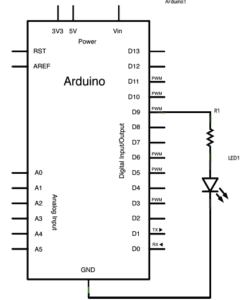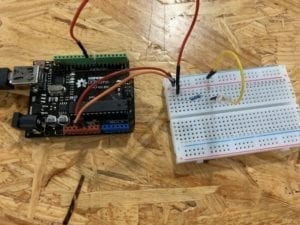Recitation 2. Arduino Basics by Zhiqiu Wang
Circuit 1: Fade
Components:
1 * Arduino Uno
1 * USB A to B cable
1 * breadboard
1 * LED
1 * 220 ohm resistor
Hook-up wires
Process:
We had a very smooth start of building the circuit because we have accumulated experience in the previous classes. With the diagram, we successfully connected every component together
There was one thing that confused us most which is two jumper cables connected on both sides of the breadboard which seems to be useless but appeared on the diagram. So we turn to the instructors for help and got the answer that they are used to connect both two sides so that no matter which side of the component was connecting, it is always included in the circuit. In this circuit, these two jumper cables are not necessary because only one side’s cable were enough for the connection of the circuit.

Circuit 2: Tone Melody
Components:
1 * Arduino Uno
1 * USB A to B cable
1 * breadboard (optional)
1 * buzzer
Hook-up wires
Process:
The process of building the second circuit also went very well because this circuit itself is a simple one. The whole circuit can function properly even without the breadboard. However, we still chose to keep the breadboard in our circuit because it provided a more stable connection and the buzzer and the hook-up wires were more easily to be connected.

Circuit 3: Speed Game
Components:
1 * Arduino Uno
1 * USB A to B cable
1 * breadboard
2 * LED
2 * 220 ohm resistor
Hook-up wires
2 * 10K ohm resistors
2 * pushbuttons
1 * buzzer
Process:
The third circuit building process was not that successful comparing to the previous two. When building up the circuit, we had some problems on differing resistors of different ohm. Though we can solve this problem by only try different resistors until it works, we decided to find a way which can tell the differences at a glance in the future. After our close observation of two different resistors we found that the distance between two colored lines are different and the color itself is actually different.
Eventually, we successfully built the circuit and played twice with the device.
Question 1
Reflect how you use technology in your daily life and on the circuits you just built. Use the text Physical Computing and your own observations to define interaction.
In my everyday life, technology is a word that I think is quite far away from me. The closest technology that is with in my reach is probably my phone and my laptop. However, in the IMA classes, after learning physical Computing, I have gradually changed my mind that technology actually can be something closely related to me and can even interact and created by me. This is the deepest impression that IMA has left on me.
Question 2
If you have 100,000 LEDs of any brightness and color at your disposal, what would you make and where would you put it?
I would put it on some of the landmark buildings in our city and add some voice sensor to it so as to display how noisy it is now in this city so as to remind the citizen to make our city a more peaceful place.